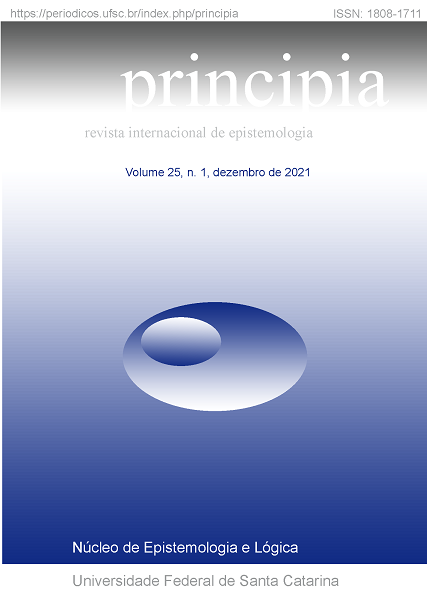La Actitud de La Obra de Arte
DOI:
https://doi.org/10.5007/1808-1711.2021.e71267Resumo
Neste artigo elaboramos uma proposta sobre como compreender o significado das obras de arte que se baseia na perspectiva de Dennett acerca da natureza da intencionalidade dos fenómenos mentais. De acordo com esta perspectiva, a intencionalidade exibida pelos fenómenos mentais não é original, mas derivada. Adotar a perspectiva da intencionalidade derivada implica que já não será possível afirmar que o significado de uma obra de arte é determinado pelas intenções que o seu autor teve ao criá-la, como as teorias intencionalistas têm defendido; por esta razão será necessário abandoná-las, pelo menos nas suas formulações disponíveis. Contudo, consideramos que existe um aspeto das teorias intencionalistas que não resulta incompatível com a perspectiva da intencionalidade derivada. É o fato de parte do significado da obra de arte ser dada pelas interpretações que surgem apenas quando se assume que foi produzida por um agente com o objetivo de transmitir algo. Iremos chamar a esta estratégia interpretativa a postura da obra de arte e argumentaremos que ela deve ser entendida como um subtipo da postura intencional. Esta estratégia interpretativa faz parte de uma proposta que tenta explicar o significado das obras de arte como parcialmente indeterminado, relativo a uma história (e não a uma origem fundacional) e dependente da atribuição interpretativa.
Referências
Arnheim, R. 1962. Picasso's Guernica. Berkeley: University of California Press.
Beardsley, M. 1981. Aesthetics, problems in the philosophy of criticism. Indianapolis: Hackett Publishing.
Boden, M. 2004. The creative mind: Myths and mechanisms. United Kingdom: Routledge.
Brentano, F. 1995 [1874]. Psychology from an Empirical Standpoint. London: Routledge.
Briskman, L. 1980. Creative product and creative process in science and art. Inquiry 23 (1): 83-106.
Bullot, N. & Reber, R. 2013. The artful mind meets art history: Toward a psycho-historical framework for the science of art appreciation. Behavioral and brain sciences 36(2): 123-37.
Carroll, N. 1997. The intentional fallacy: Defending myself. The Journal of Aesthetics and Art Criticism 55(3): 305-9.
Carroll, N. 2000. Interpretation and intention: The debate between hypothetical and actual intentionalism". Metaphilosophy 31(2): 75-95.
Clark, A. 2002. That Special Something: Dennett on the Making of Minds and Selves. En: A. Brook and D. Ross (eds) Daniel Dennett, p.187- 205. Cambridge: Cambridge University Press.
Cope, D. 2004. Virtual music: computer synthesis of musical style. Cambridge: The MIT press.
Currie, G. 1995. Image and mind: Film, philosophy and cognitive science, Cambridge: Cambridge University Press.
Danto, A. 1964. The artworld. The journal of philosophy, 61(19): 571-84.
Danto, A. 1981. The Transfiguration of the Commonplace. Cambridge: Harvard University Press.
Davies, D. 2009. The Artistic Relevance of Creativity. En: Krausz, M., Dutton, D., & Bardsley, K. (eds.) The Idea of Creativity, p.213-34. Netherlands: Brill.
Dawkins, R. 1976. The selfish gene. Oxford: Oxford university press.
Dennett, D. 1998 [1987]. La actitud intencional. Trad. Zadunaisky. Barcelona: Gedisa.
Dennett, D. 1990. The interpretation of texts, people and other artifacts. Philosophy and phenomenological research, 50: 177-94.
Dennett, D. 1991. Real patterns. The journal of Philosophy, 88(1): 27-51.
Dennett, D. 1995. Darwin's dangerous idea. New York: Simon y Schuster, Inc.
Farrell, J. 2017. The Varieties of Authorial Intention: Literary Theory Beyond the Intentional Fallacy. Cham: Springer.
Gardner, H. 1970. Children's sensitivity to painting styles. Child Development 41(3): 813-21.
Goodman, N. 1976. Languages of Art: An Approach to a Theory of Symbols, 2nd edition. Indianapolis: Hackett Publishing Company.
Goodman, N. 1990 [1978]. Ways of Worldmaking. Madrid: La balsa de la medusa.
Gaut, B. 2010. A philosophy of cinematic art. Cambridge: Cambridge University Press.
Hirsch, E. 1967a. Validity in Interpretation. New Haven, CT: Yale University Press.
Hirsch, E. 1967b. In defense of the author. En: Iseminger, Gary (Eds.) (1992) Intention and interpretation, p.11-23. Philadelphia: Temple University Press.
Haugeland, J. 1998. Having thought. Cambridge: Harvard University Press.
Iseminger, G. (Eds.) 1992. Intention and interpretation, Philadelphia: Temple University Press.
Iseminger, G. 1996. Actual intentionalism vs. hypothetical intentionalism. The journal of aesthetics and art criticism, 54(4): 319-26.
Levinson, J. 1996. The pleasures of aesthetics: Philosophical essays. New York: Cornell University Press.
Linson, A. 2013. The expressive stance: Intentionality, expression, and machine art. International Journal of Machine Consciousness 5(2): 195-216.
Lyas, C. 1992. Wittgensteinian intentions. En: Iseminger, Gary (Eds.) (1992) Intention and interpretation, p.132-51. Philadelphia: Temple University Press.
Machotka, P. 1966. Aesthetic criteria in childhood: Justifications of preference. Child Development 37(4): 877-85.
Nünning, V., Nünning, A. & Neumann, B. (Eds.). (2010). Cultural ways of worldmaking: Media and narratives (Vol. 1). Walter de Gruyter.
Quine, W. 1969 [1960]. Word and object. Cambridge: Technology Press of Massachusetts Institute of Technology.
Searle, J. 1982. The myth of the computer. The New York Review of Books 29(7): 3-6.
Searle, J. 1992 [1983]. Intencionalidad: Un ensayo en filosofía de la mente. Madrid: Tecnos.
Spingarn, J. 1984 [1924]. Criticism in America. New York: Core Collection Micropublications.
Thomas, A. 2018. The Definition of Art. The Stanford Encyclopedia of Philosophy (Fall 2018 Edition), Edward N. Zalta (ed.), URL = <https://plato.stanford.edu/archives/fall2018/entries/art-definition/>.
Tolhurst, W. 1979. On what a text is and how it means. The British Journal of Aesthetics 19(1): 3-14.
Wimsatt, W. & Beardsley, M. 1946. The intentional fallacy. The Sewanee Review 54(3): 468-88.
Wreen, M. 2014. Beardsley's Aesthetics. The Stanford Encyclopedia of Philosophy (Winter 2014 Edition), Edward N. Zalta (ed.), URL: /https://plato.stanford.edu/archives/win2014/entries/beardsley-aesthetics/ (21/01/2020)
Antunes, J. 2017. Baronesa, Brasil. Película.
Loznitsa, S. 2016. Austerlitz, Alemania. Película.
Downloads
Publicado
Edição
Seção
Licença
Copyright (c) 2021 Malena León

Este trabalho está licenciado sob uma licença Creative Commons Attribution-NonCommercial-NoDerivatives 4.0 International License.

A obra Principia de http://www.periodicos.ufsc.br/index.php/principia/index foi licenciada com uma Licença Creative Commons Atribuição-NãoComercial-SemDerivações 4.0 Internacional.
Com base na obra disponível em www.periodicos.ufsc.br.



